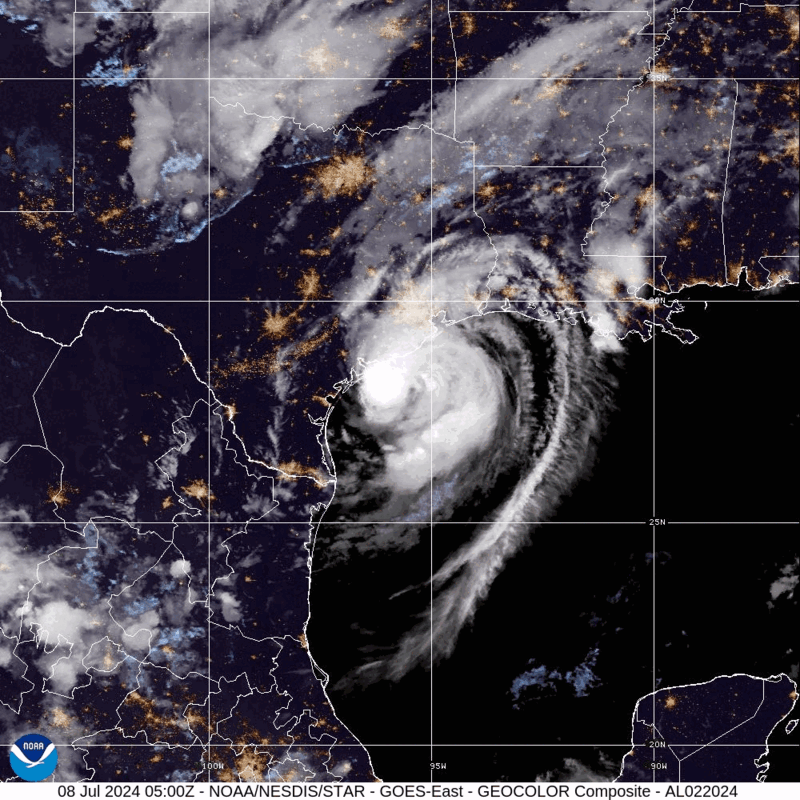Hurricane Beryl makes landfall in Texas, as heat wave continues in the West
Both Category 1 hurricane, although weakened in strength, and the high temperatures will move inland.

Satellite images of Beryl.
Beryl made landfall early Monday morning near Matagorda Beach, Texas, bringing 80 mph winds and storm surge, along with heavy rain and strong winds in various parts of the state.
The National Hurricane Center (NHC) reported that the hurricane warning extends from Mesquite Bay to Port Bolivar.
Also, urban flooding is expected in the Gulf of Texas and the east of the state and river flooding, although on a smaller scale.
Experts forecast that Beryl, which made landfall at the U.S. coast as a Category 1 hurricane, will weaken to a tropical storm before moving across eastern Texas. It will continue to weaken as it moves toward Arkansas, becoming a tropical depression.
Statewide, more than 270,000 people were left without power, according to PowerOutage.us. The areas most affected at the time of arrival of Beryl are Matagorda and surrounding areas.
After its deadly passage through the Caribbean, Beryl caused material damage in Mexico, although there are currently no deaths were reported in the country. Although it weakened as it passed through Mexico, downgrading to a tropical storm, it regained momentum as it approached the United States, leading authorities to issue hurricane warnings on Sunday and call for accelerated preparations.
Initial warnings were extended as it strengthened, reaching areas such as Houston. "To all Houstonians: we have to take Beryl very, very seriously," said the city's mayor, John Whitmire.
"Our worst enemy is complacency," he said before insisting that, despite the early warning of the storm's arrival, "it's still very unpredictable."
He also reported that there would be no summer school on Monday or Tuesday and that city employees should work from home. However, the worst of Beryl, he noted, will be at night:
I want Houstonians to know the conditions you go to sleep under tonight will not be the same that you wake up to in the morning.
The National Weather Service (NWS) also issued a tornado watch for Houston, the state's most populous city, until 10 AM CDT Monday. The notice covers eight counties: Brazoria, Chambers, Fort Bend, Galveston, Harris, Liberty, Matagorda and Montgomery.
Heat wave to move eastward
As Beryl makes landfall on the Texas coast, the extreme heat wave continues in the eastern part of the country.
"Widespread high and low temperature records will likely be tied or broken over the next couple of days as a result of this unusual heat," the NWS reported.
It also forecasted that by midweek the heat wave will move northward and inland, from Washington to Arizona. It will make its way toward Oregon and California, where the official website of the Department of Forestry and Fire Prevention reported more than 3,000 fires as of early Monday morning.
The Lake Fire, in Santa Barbara County, forced the Sheriff's Department to issue evacuation orders Saturday night. According to local newspapers, the evacuated areas includes the area where Neverland, Michael Jackson's former family ranch, was located.
In Oregon, Gov. Tina Kotek declared a state of emergency. "It's pretty unusual for this area to get these kinds of temperatures for this kind of duration," NWS meteorologist Noah Alviz said in a statement collected by Oregon Public Broadcasting.
According to the same local media outlet, since Friday at least six people have been hospitalized for heat-related illnesses.
'Killer' weather
Although it can affect everyone, high temperatures are especially dangerous for older adults, pregnant women and patients suffering from chronic conditions.
Children are also especially vulnerable, so authorities caution parents to be extra careful. Among other recommendations, they ask that they be careful and not leave them inside the car. They also recommend parents lock their car doors to prevent kids from getting in parked vehicles. In fact, so far this year seven children under the age of eight have died from this cause.
From the NWS, they also stress the importance of being on the lookout for symptoms of cramping, swelling and heat stroke, which they explain on their website.
RECOMMENDATION





















